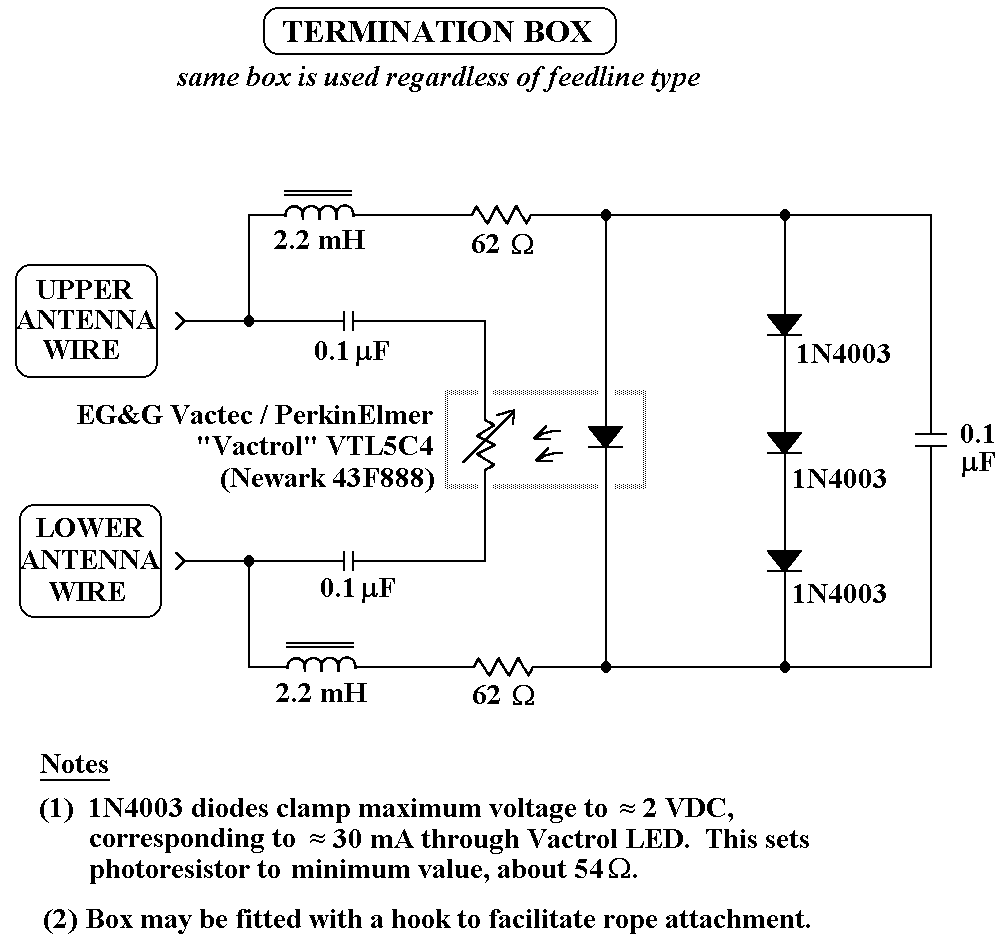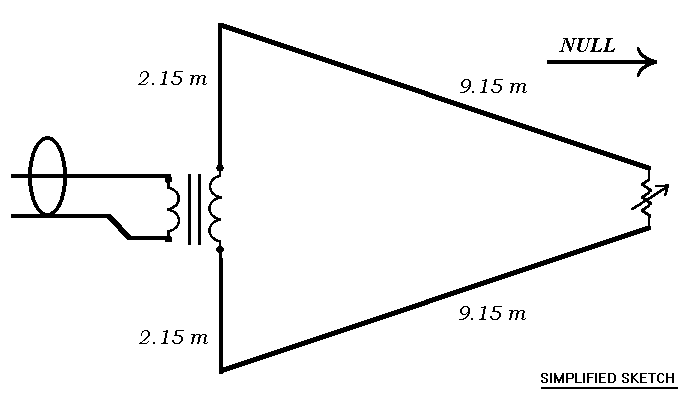
Pennant Antenna with Remote Termination Control
Mark Connelly,
WA1ION - 19 JUL 2000
 Introduction
Introduction
The July 2000 issue of QST magazine published an article by Earl W. Cunningham, K6SE, entitled "Flags, Pennants, and Other Ground-Independent Low Band Receiving Antennas". The work presented in the article includes research by several other hams including Jose, EA3VY. The class of antennas discussed comprises single-turn loops terminated on the side opposite the feedpoint. The termination effects a null off the end where the terminator is located, thereby producing a cardioid (heart-shaped) directional pick-up pattern. The antenna is broadband rather than resonant. The pattern produced holds up well over a wide frequency range. Earl has run EZNEC computer simulations to calculate lengths which give a non-reactive feedpoint impedance to ensure wideband coverage. The dimensions of the antenna are small enough to permit installation in the backyards of typical suburban residences. See the figure above for pennant style antenna dimensions derived from computer optimizations.
What I have done to improve upon the original concept is to incorporate the remote termination control methods previously used with great success by Steve Byan for Beverage termination and, subsequently, by Al Merriman and Andy Ikin, for K9AY Loop termination. The merits of both of these prior implementations have been conclusively validated in real-world experiences during several Newfoundland DXpeditions.
The remotely-controlled resistance element is a "Vactrol", part number VTL5C4, made by Perkin-Elmer, formerly EG&G Vactec. It uses an LED optically coupled to a photoresistor. At 0 mA through the LED, the photoresistor is a high value, greater than 10K ohms. At 30 mA LED current, the photoresistor value decreases to less than 60 ohms. Intermediate values of LED current produce intermediate resistance values. DC is fed to the LED through RF chokes to prevent undesired loading effects at radio frequencies. DC blocking capacitors allow RF to go through the photoresistor termination without letting DC flow through it.
Remote control of the pennant's termination resistance provides optimum null depth on the principal axis (in the direction that points towards, and beyond, the termination as viewed from the feedpoint). Additionally, test data taken indicate that termination adjustment allows a certain degree of null slewing up to about 45 degrees off the principal null axis. Achievable null depth decreases as a null is placed farther (in an angular sense) from the principal axis, but slewing the null by using a slightly different termination resistance can still produce a superior null in that direction than if the deepest principal-axis null was used instead. An example would be an antenna configured with the termination west of the feedpoint. Station "A" is due west and station "B" is northwest. With the termination adjusted for the typical 35 dB or better west null of Station "A", station "B" is down about 13 dB (based on the curves in Earl's article). By slewing the null with a slightly different termination resistance, the reduction of station "A" would deteriorate, but rejection of "B" may be increased to 20 dB or so. This finding has been determined by experimentation; I have no formal simulation data to back it up. In any event, there are differences in optimum termination resistance which are affected by bearing, frequency, skip angle, weather, stray coupling to external objects / structures, and imperfections in the load at the feedpoint of the antenna. Because of these variations in the resistance needed for each optimum null solution, the ability to control the termination remotely is highly desirable, just as in the case of the K9AY Loop.
Pennant antennas seem to have a bit deeper null than Flag antennas (a rectangular version of the design), so the pennant will be the main focus of this article. Earl Cunningham's article goes into all the design permutations and it gives detailed directional patterns. His use of all these antenna types concentrates on their application in the 160, 80, and 40 meter ham bands (1.8, 3.5, and 7 MHz). I corresponded with Earl via e-mail to see if he could suggest any alterations of the design for usage on medium-wave frequencies (500 to 1800 kHz). He stated that the original dimensions would work fine, just that the efficiency (sensitivity) would be low and that amplification would be required to get gain anywhere near that of slopers, longwires, dipoles, or other conventional outdoor antennas.
See my BBVA-A documentation at http://www.qsl.net/wa1ion/bbva/bbva_a.htm for an amplifier design which may be suitable.
 Testing
Testing
Tests were performed at a site in West Yarmouth, MA as well as at my home in Billerica, MA. Findings at both locations were similar. At Billerica, maximum amplifier gain is limited because 50 kW WRKO-680 is only 5 km / 3 miles away. Amplifier or receiver overloading may be caused by WRKO and several other locals including WNRB-1510. Furthermore, the local electrical noise at Billerica (from nearby TV's, light dimmers, computers, etc.) sometimes exceeds S9, making weaker signal evaluation difficult or impossible. For these reasons, the tables below represent measurements taken at the site on Trowbridge Path in West Yarmouth (GC= 70.223 W / 41.682 N).
The vertical portion of the antenna was supported by a nylon rope going to the top of a 15 m / 50 ft. pitch pine tree. The rope was adjusted for a bottom insulator height of about 3 m: that made the top insulator height about 7.3 m. The bottom insulator was tied via nylon rope to a tent stake to provide correct tension on the vertical section of the pendant. The termination end, west of the feedpoint, was supported by a plastic-hooked non-conductive bungee cord going to low branches in another pine tree. As direct measurement of termination resistance was not possible during operation, the voltage measured at the arm of the controller's potentiometer was recorded instead. Table 3 below relates this voltage to the termination photoresistor's ohmic value.
The test results show that the pennant antenna with remote termination provides a cardioid pick-up pattern from a single antenna without the need for a phasing unit. Tests with a K9AY antenna in the same position at the West Yarmouth site a month earlier showed best-case nulls of only about 15 dB. The ground at the site is almost pure sand, so I'm sure that the more-fussy grounding requirements of the K9AY degraded its performance. The beauty of the pennant and similar designs is that ground conditions do not have much effect on the achievable null depth. A properly-constructed pennant should have at least 30 dB of null depth on the principal axis even in situations as different as a salt-marsh or a pile of rocks and sand. Height of the pennant antenna doesn't have all that much effect either (although I don't think that the bottom point should be much lower than about 2 m / 6.6 ft.). The main benefit of raising the antenna to a much greater height would be to reduce local electrical noise and, perhaps, to increase sensitivity a bit in poor-ground areas.
 Coaxial Cable versus Twinlead feed
Coaxial Cable versus Twinlead feed
A system fed with 50 ohm coaxial cable requires Coaxial Controller, Feedpoint, and Termination box assemblies. The Feedpoint Box provides an impedance transformation from approximately 800 ohms antenna impedance to 50 ohms receiver input impedance. This is done by means of a 16:1 RF transformer, Mini-Circuits part number T16-6T-X65 or a suitable homebrew equivalent.
A system fed with 300 ohm twinlead requires just a Twinlead Controller box and a Termination box. Twinlead goes from the controller straight to the antenna feedpoint, at which it is connected directly to the upper and lower wires of the pennant. The required impedance transformer is located in the Twinlead Controller Box.
Maximum suggested twinlead feedline length is about 30 m / 100 ft. Coaxially-fed systems can be located farther from the operating position, perhaps as much as 100 m / 328 ft. without a great amount of signal loss below 2 MHz.
The layouts of the Controller, Feedpoint, and Termination boxes are not critical. Documentation presented herein is limited to electrical schematics. Commonly-available parts are noted by value only. Unusual components are noted with vendor stock numbers. For a list of parts vendors I use often, check vendors.htm .
Test data tables below are for a coaxially-fed unamplified pennant antenna (Table 1) and for a twinlead-fed pennant system with a BBVA-A amplifier providing about 30 dB of gain (Table 2).
Stations shown are a representative sample. For an "unabridged" daytime bandscan at this site, go to w_yarmouth_day_scan.htm .
Table 1: Pennant Antenna fed with Coaxial Cable (employing Coaxial Controller, Feedpoint, and Termination boxes) - no amplification:
|
COAXIAL CABLE IMPLEMENTATION |
|||||||||
|
BEARING |
dB o/S-0 |
ohms |
dB o/S-0 |
ohms |
dB |
||||
|
FREQ |
CALL |
ST. |
DEG |
Pennant |
Pennant |
Pennant |
Pennant |
null depth |
|
|
Peak |
peak R |
Null |
null R |
||||||
|
730 |
WJTO |
ME |
6.98 |
45 |
> 20K |
39 |
54 |
6 |
|
|
620 |
WZON |
ME |
17.87 |
34 |
> 20K |
30 |
54 |
4 |
|
|
910 |
WABI |
ME |
18.69 |
33 |
> 20K |
30 |
54 |
3 |
|
|
1170 |
WFPB |
MA |
82.99 |
56 |
> 20K |
52 |
54 |
4 |
|
|
1240 |
WBUR |
MA |
189.49 |
89 |
> 20K |
82 |
486 |
7 |
|
|
820 |
WNYC |
NY |
253.68 |
38 |
54 |
9 |
1197 |
29 |
|
|
570 |
WMCA |
NY |
253.68 |
39 |
54, > 20K |
15 |
970 |
24 |
|
|
880 |
WCBS |
NY |
254.16 |
48 |
54 |
15 |
970 |
33 |
|
|
660 |
WFAN |
NY |
254.16 |
51 |
> 20K |
27 |
1197 |
24 |
|
|
1130 |
WBBR |
NY |
254.25 |
28 |
54, > 20K |
9 |
1135 |
19 |
|
|
710 |
WOR |
NY |
254.32 |
39 |
> 20K |
12 |
1070 |
27 |
|
|
1050 |
WEVD |
NY |
254.50 |
44 |
54 |
15 |
1018 |
29 |
|
|
1010 |
WINS |
NY |
254.60 |
45 |
54 |
15 |
970 |
30 |
|
|
770 |
WABC |
NY |
255.53 |
38 |
54 |
9 |
970 |
29 |
|
|
1340 |
WNBH |
MA |
263.89 |
51 |
> 20K |
33 |
1018 |
18 |
|
|
1420 |
WBSM |
MA |
266.99 |
48 |
> 20K |
30 |
1018 |
18 |
|
|
1590 |
WARV |
RI |
273.36 |
42 |
> 20K |
15 |
970 |
27 |
|
|
1480 |
WSAR |
MA |
273.79 |
45 |
54, > 20K |
18 |
1018 |
27 |
|
|
630 |
WPRO |
RI |
276.91 |
43 |
54, > 20K |
21 |
1018 |
22 |
|
|
920 |
WHJJ |
RI |
277.34 |
27 |
54 |
6 |
923 |
21 |
|
|
790 |
WSKO |
RI |
280.61 |
39 |
54 |
18 |
781 |
21 |
|
|
550 |
WLKW |
RI |
284.73 |
48 |
> 20K |
15 |
752 |
33 |
|
|
990 |
WALE |
RI |
285.23 |
42 |
54, > 20K |
9 |
843 |
33 |
|
|
810 |
WGY |
NY |
292.96 |
24 |
> 20K |
3 |
678 |
21 |
|
|
760 |
WVNE |
MA |
293.01 |
51 |
> 20K |
15 |
616 |
36 |
|
|
830 |
WCRN |
MA |
294.60 |
36 |
> 20K |
9 |
635 |
27 |
|
|
890 |
WBPS |
MA |
302.83 |
51 |
54 |
30 |
524 |
21 |
|
|
1200 |
WKOX |
MA |
304.41 |
45 |
> 20K |
12 |
616 |
33 |
|
|
1060 |
WMEX |
MA |
304.43 |
51 |
> 20K |
24 |
498 |
27 |
|
|
850 |
WEEI |
MA |
307.88 |
58 |
> 20K |
39 |
472 |
19 |
|
|
1390 |
WPLM |
MA |
308.91 |
62 |
> 20K |
45 |
616 |
17 |
|
|
1600 |
WUNR |
MA |
310.38 |
45 |
> 20K |
27 |
535 |
18 |
|
|
1330 |
WRCA |
MA |
311.40 |
42 |
> 20K |
15 |
524 |
27 |
|
|
1260 |
WMKI |
MA |
314.27 |
51 |
> 20K |
33 |
432 |
18 |
|
|
1510 |
WNRB |
MA |
314.45 |
48 |
> 20K |
27 |
486 |
21 |
|
|
1150 |
WAMG |
MA |
315.24 |
50 |
> 20K |
32 |
360 |
18 |
|
|
1300 |
WJDA |
MA |
316.11 |
48 |
> 20K |
33 |
472 |
15 |
|
|
740 |
WJIB |
MA |
316.31 |
44 |
> 20K |
27 |
444 |
17 |
|
|
680 |
WRKO |
MA |
317.90 |
66 |
> 20K |
51 |
335 |
15 |
|
|
590 |
WEZE |
MA |
318.74 |
61 |
> 20K |
48 |
372 |
13 |
|
|
1430 |
WXKS |
MA |
319.01 |
58 |
> 20K |
43 |
472 |
15 |
|
|
1090 |
WILD |
MA |
319.33 |
59 |
> 20K |
44 |
322 |
15 |
|
|
1030 |
WBZ |
MA |
321.06 |
64 |
> 20K |
48 |
303 |
16 |
|
|
950 |
WROL |
MA |
323.04 |
70 |
> 20K |
54 |
353 |
16 |
|
|
1360 |
WLYN |
MA |
324.23 |
60 |
> 20K |
45 |
285 |
15 |
|
|
800 |
WCCM |
MA |
324.43 |
42 |
> 20K |
26 |
326 |
16 |
|
|
610 |
WGIR |
NH |
327.26 |
42 |
> 20K |
27 |
303 |
15 |
|
|
1230 |
WESX |
MA |
330.63 |
54 |
> 20K |
42 |
232 |
12 |
|
|
1570 |
WNSH |
MA |
332.68 |
42 |
> 20K |
30 |
54 |
12 |
|
|
1450 |
WNBP |
MA |
337.65 |
51 |
> 20K |
39 |
54 |
12 |
|
|
930 |
WGIN |
NH |
341.76 |
45 |
> 20K |
33 |
54 |
12 |
|
|
1270 |
WTSN |
NH |
342.93 |
42 |
> 20K |
30 |
54 |
12 |
|
|
870 |
WLAM |
ME |
354.28 |
44 |
> 20K |
34 |
54 |
10 |
|
|
1440 |
WJAE |
ME |
356.69 |
48 |
> 20K |
39 |
54 |
9 |
|
|
970 |
WZAN |
ME |
357.81 |
59 |
> 20K |
45 |
54 |
14 |
|
|
560 |
WGAN |
ME |
358.01 |
51 |
> 20K |
45 |
> 20K |
6 |
|
|
1490 |
WBAE |
ME |
358.93 |
45 |
> 20K |
39 |
54 |
6 |
|
Table 2: Pennant Antenna fed with Twinlead Cable (employing Twinlead Controller and Termination boxes), 30 dB amplification:
|
TWINLEAD IMPLEMENTATION |
|||||||||
|
BEARING |
dB o/S-0 |
ohms |
dB o/S-0 |
ohms |
dB |
||||
|
FREQ |
CALL |
ST. |
DEG |
Pennant |
Pennant |
Pennant |
Pennant |
null depth |
|
|
peak |
peak R |
null |
null R |
||||||
|
620 |
WZON |
ME |
17.87 |
63 |
> 20K |
60 |
54 |
3 |
|
|
910 |
WABI |
ME |
18.69 |
59 |
no var. |
59 |
no var. |
0 |
|
|
1170 |
WFPB |
MA |
82.99 |
88 |
54 |
84 |
> 20K |
4 |
|
|
1240 |
WBUR |
MA |
189.49 |
119 |
54 |
84 |
2300 |
35 |
|
|
820 |
WNYC |
NY |
253.68 |
71 |
54 |
39 |
1135 |
32 |
|
|
570 |
WMCA |
NY |
253.68 |
73 |
> 20K |
52 |
879 |
21 |
|
|
880 |
WCBS |
NY |
254.16 |
87 |
54 |
51 |
843 |
36 |
|
|
660 |
WFAN |
NY |
254.16 |
88 |
54 |
58 |
923 |
30 |
|
|
1130 |
WBBR |
NY |
254.25 |
81 |
54 |
45 |
1018 |
36 |
|
|
710 |
WOR |
NY |
254.32 |
73 |
54 |
45 |
970 |
28 |
|
|
1050 |
WEVD |
NY |
254.50 |
82 |
54 |
48 |
923 |
34 |
|
|
1010 |
WINS |
NY |
254.60 |
84 |
54 |
50 |
970 |
34 |
|
|
770 |
WABC |
NY |
255.53 |
70 |
54 |
33 |
879 |
37 |
|
|
1340 |
WNBH |
MA |
263.89 |
89 |
54 |
56 |
1018 |
33 |
|
|
1420 |
WBSM |
MA |
266.99 |
84 |
54 |
45 |
1135 |
39 |
|
|
630 |
WPRO |
RI |
276.91 |
81 |
> 20K |
56 |
752 |
25 |
|
|
920 |
WHJJ |
RI |
277.34 |
60 |
54 |
42 |
879 |
18 |
|
|
790 |
WSKO |
RI |
280.61 |
74 |
54 |
51 |
923 |
23 |
|
|
1290 |
WRNI |
RI |
281.30 |
79 |
54 |
42 |
923 |
37 |
|
|
810 |
WGY |
NY |
292.96 |
56 |
54 |
36 |
582 |
20 |
|
|
760 |
WVNE |
MA |
293.01 |
66 |
54, >20K |
51 |
551 |
15 |
|
|
830 |
WCRN |
MA |
294.60 |
66 |
54 |
48 |
598 |
18 |
|
|
890 |
WBPS |
MA |
302.83 |
84 |
54 |
61 |
524 |
23 |
|
|
1200 |
WKOX |
MA |
304.41 |
83 |
54 |
54 |
678 |
29 |
|
|
1060 |
WMEX |
MA |
304.43 |
84 |
54 |
58 |
565 |
26 |
|
|
850 |
WEEI |
MA |
307.88 |
89 |
> 20K |
76 |
480 |
13 |
|
|
1260 |
WMKI |
MA |
314.27 |
89 |
54 |
72 |
486 |
17 |
|
|
1300 |
WJDA |
MA |
316.11 |
82 |
54 |
64 |
455 |
18 |
|
|
1030 |
WBZ |
MA |
321.06 |
93 |
54 |
86 |
278 |
7 |
|
|
950 |
WROL |
MA |
323.04 |
94 |
54 |
89 |
306 |
5 |
|
|
1360 |
WLYN |
MA |
324.23 |
89 |
54 |
83 |
353 |
6 |
|
|
800 |
WCCM |
MA |
324.43 |
73 |
> 20K |
58 |
295 |
15 |
|
|
1450 |
WNBP |
MA |
337.65 |
83 |
54 |
77 |
480 |
6 |
|
|
1440 |
WJAE |
ME |
356.69 |
81 |
54 |
76 |
> 20K |
5 |
|
|
970 |
WZAN |
ME |
357.81 |
89 |
no var. |
89 |
no var. |
0 |
|
|
560 |
WGAN |
ME |
358.01 |
86 |
> 20K |
74 |
54 |
12 |
|
The coaxially-fed system exhibits nulls up to 36 dB with best performance at about 290 degrees and the twinlead-fed system reaches 39 dB of null depth with best performance near 270 degrees (i.e. due west). I'm not sure how the feedline chosen has an effect on best null angle, other than perhaps by unintended coupling to the antenna element. Null depth in the 250 - 330 degree bearing range is shown in Chart 1. This chart would have been extended down to 230 degrees for symmetry, but there weren't enough suitable stations on 230 - 250 degree bearings to provide useful data.
Chart 1: Null Depth
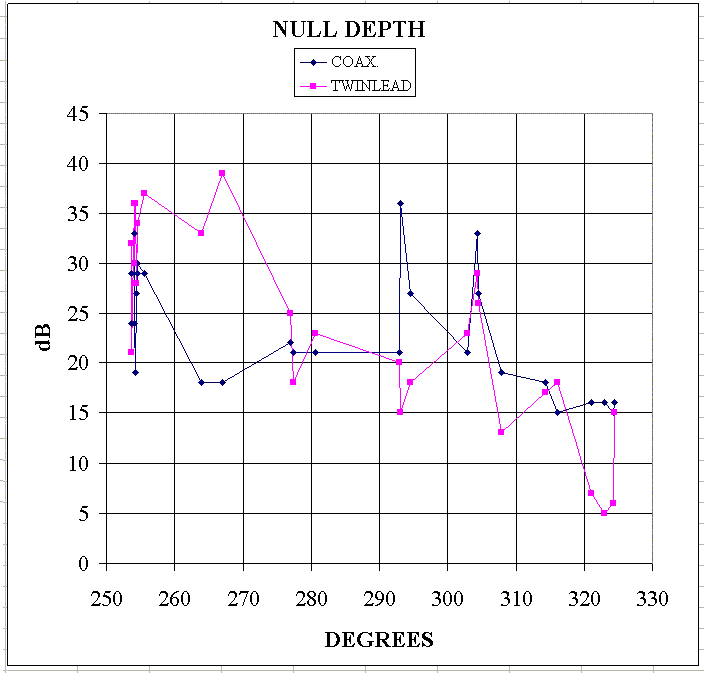
As noted in the introductory discussion, the resistance required for a null varies with the bearing of the null. Deepest nulls, in the principal design direction of the antenna, occur with resistance values of 700 to 1000 ohms. Depths of 30 dB or better, at least on stable groundwave signals, can be expected within 10 degrees of the optimum bearing with resistances in the 700 to 1000 ohm window. An interesting fact that came up, not mentioned in the K6SE article, is that nulls can be "slewed" well off the principal axis, admittedly with decreased null depth at greater bearing deviations. Tables 1 and 2 above, and Chart 2 below, show that bearings counterclockwise (anticlockwise) of optimum require null resistances greater than normal values. Nulls on bearings clockwise of optimum require null resistance values that are lower: down to about 300 ohms.
Chart 2: Null Resistance
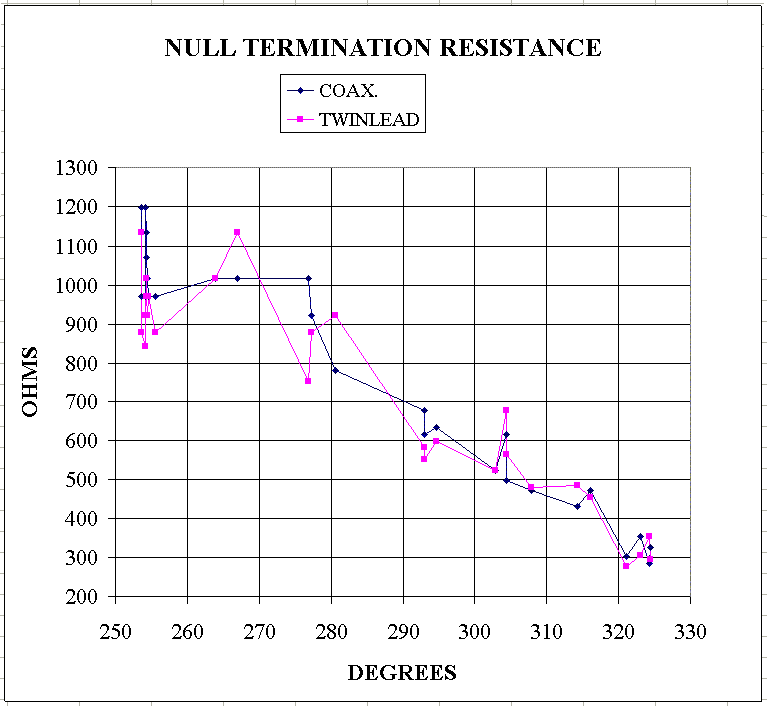
Null resistances were measured by measuring control voltage during reception tests and then calibrating voltage versus resistance with the system brought indoors (termination box opened up). Table 3 shows the calibration factors.
Table 3: Control Voltage versus Null Resistance and Vactrol LED Current
|
VTL5C4 VACTROL - CONTROLLED |
||||||||
|
PENNANT ANTENNA TERMINATION |
||||||||
|
V (pot) |
V (wires) |
ohms |
mA |
V (pot) |
V (wires) |
ohms |
mA |
|
|
<1.3 |
=V (pot) |
> 20K |
0.00 |
1.95 |
1.742 |
480 |
1.43 |
|
|
1.50 |
1.478 |
10K |
0.15 |
1.96 |
1.748 |
472 |
1.46 |
|
|
1.60 |
1.546 |
2300 |
0.37 |
1.98 |
1.759 |
455 |
1.53 |
|
|
1.65 |
1.577 |
1570 |
0.50 |
2.00 |
1.770 |
432 |
1.59 |
|
|
1.66 |
1.583 |
1450 |
0.53 |
2.02 |
1.780 |
419 |
1.66 |
|
|
1.67 |
1.589 |
1365 |
0.56 |
2.04 |
1.790 |
400 |
1.72 |
|
|
1.68 |
1.595 |
1273 |
0.59 |
2.06 |
1.800 |
390 |
1.79 |
|
|
1.69 |
1.601 |
1197 |
0.61 |
2.08 |
1.810 |
372 |
1.86 |
|
|
1.70 |
1.607 |
1135 |
0.64 |
2.10 |
1.820 |
360 |
1.93 |
|
|
1.71 |
1.613 |
1070 |
0.67 |
2.12 |
1.830 |
353 |
2.00 |
|
|
1.72 |
1.619 |
1018 |
0.70 |
2.14 |
1.840 |
339 |
2.07 |
|
|
1.73 |
1.624 |
970 |
0.73 |
2.16 |
1.850 |
330 |
2.14 |
|
|
1.74 |
1.630 |
923 |
0.76 |
2.18 |
1.860 |
322 |
2.21 |
|
|
1.75 |
1.636 |
879 |
0.79 |
2.20 |
1.870 |
314 |
2.28 |
|
|
1.76 |
1.642 |
843 |
0.82 |
2.25 |
1.895 |
295 |
2.45 |
|
|
1.77 |
1.648 |
811 |
0.84 |
2.30 |
1.920 |
278 |
2.62 |
|
|
1.78 |
1.653 |
781 |
0.87 |
2.35 |
1.945 |
264 |
2.79 |
|
|
1.79 |
1.659 |
752 |
0.90 |
2.40 |
1.970 |
250 |
2.97 |
|
|
1.80 |
1.665 |
726 |
0.93 |
2.45 |
1.995 |
238 |
3.14 |
|
|
1.81 |
1.670 |
699 |
0.97 |
2.50 |
2.020 |
228 |
3.31 |
|
|
1.82 |
1.675 |
678 |
1.00 |
2.55 |
2.048 |
220 |
3.46 |
|
|
1.83 |
1.680 |
655 |
1.04 |
2.60 |
2.076 |
213 |
3.61 |
|
|
1.84 |
1.685 |
635 |
1.07 |
2.65 |
2.104 |
204 |
3.77 |
|
|
1.85 |
1.690 |
616 |
1.11 |
2.70 |
2.132 |
197 |
3.92 |
|
|
1.86 |
1.694 |
598 |
1.14 |
2.75 |
2.160 |
191 |
4.07 |
|
|
1.87 |
1.699 |
582 |
1.18 |
2.80 |
2.188 |
187 |
4.22 |
|
|
1.88 |
1.704 |
565 |
1.21 |
2.90 |
2.244 |
176 |
4.52 |
|
|
1.89 |
1.709 |
551 |
1.25 |
3.00 |
2.300 |
166 |
4.83 |
|
|
1.90 |
1.714 |
535 |
1.28 |
3.50 |
2.510 |
132 |
6.83 |
|
|
1.91 |
1.720 |
524 |
1.31 |
5.50 |
3.500 |
82 |
13.79 |
|
|
1.92 |
1.725 |
512 |
1.34 |
10.00 |
5.790 |
54 |
29.03 |
|
|
1.93 |
1.731 |
498 |
1.37 |
|||||
|
1.94 |
1.736 |
486 |
1.40 |
|||||
 Phased Arrays
Phased Arrays
Phased arrays of pennants can be used to deepen the null (enhancing front-to-back ratio) and to focus the pick-up area into a narrower lobe, approaching Beverage-like tightness. In situations such as the 160-m band, with a narrow overall bandwidth to cover, one can make use of simple phasing methods, such as specific feedline lengths acting as delay lines. On the AM broadcast band, with a nearly 4 to 1 maximum to minimum frequency ratio, a phasing unit offering continuous shifting over 360 degrees must be used. There are many units which will provide this functionality: these include modified versions of the commercially-available MFJ-1026. The simplest phased array would be two pennants spaced a minimum of 1/12 wavelength and a maximum of 1/3 wavelength apart along the desired peak-null axis. A medium wave example: With signals to the west to be eliminated, place two pennant antennas about 50 m / 164 ft. apart on an east-west line. First, configure each antenna for best-possible cardioids nulling west. Present the two antennas' contributions to the phasing unit's inputs and then adjust the phase and amplitude controls to remove whatever vestiges of western signals that are still there to interfere with desired DX stations from the northeast, east, and southeast. See phased_arrays.htm for further discussions of phased arrays.
 Electrical Noise Considerations
Electrical Noise Considerations
As noted previously, local electrical noise can be reduced by trying different heights of the pennant system above ground. The pennant, like the K9AY, sums electrical (E) and magnetic (H) field pick-ups to produce a cardioid pattern. This is similar to using an active whip and a broadband magnetic loop as the two inputs to a phasing unit: that's what I typically use on car DXpeditions.
Since the electrical field pick-up often contains locally-generated noise to a greater extent than what's intercepted by a balanced magnetic field loop antenna, combined E-field / H-field systems like the pennant, K9AY, or Ewe might not be as "quiet" or as usable as a traditional loop for weak-signal work in average residential areas. Two or more magnetic loops used as elements of a phased array can create cardioid directionality with less local noise pick-up; the price you pay is greater null adjustment complexity as contrasted with the pennant or similar single-antenna system.
 Conclusions
Conclusions
At most sites, the pennant antenna offers a simple single-antenna method of producing a cardioid pattern. Use of a remotely-controlled termination resistance allows a degree of slewing the null bearing and depth to reduce interference from numerous stations in the approximate opposite direction of DX targets being chased. In many cases, especially when grounding for a K9AY system is inadequate, the pennant represents the best receiving-antenna solution at sites having limited space.
 Construction Drawings
Construction Drawings
Figure 1: Overall View of Antenna System
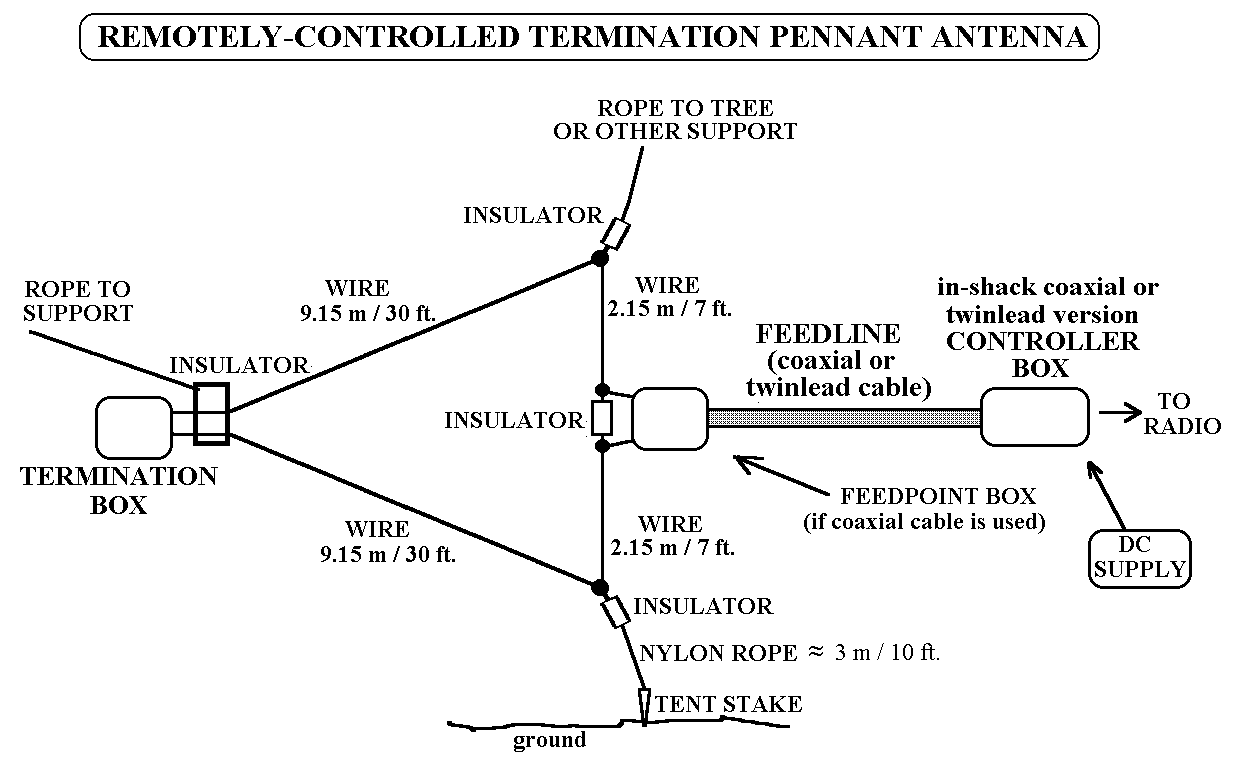
Figure 2: Twinlead Controller Box
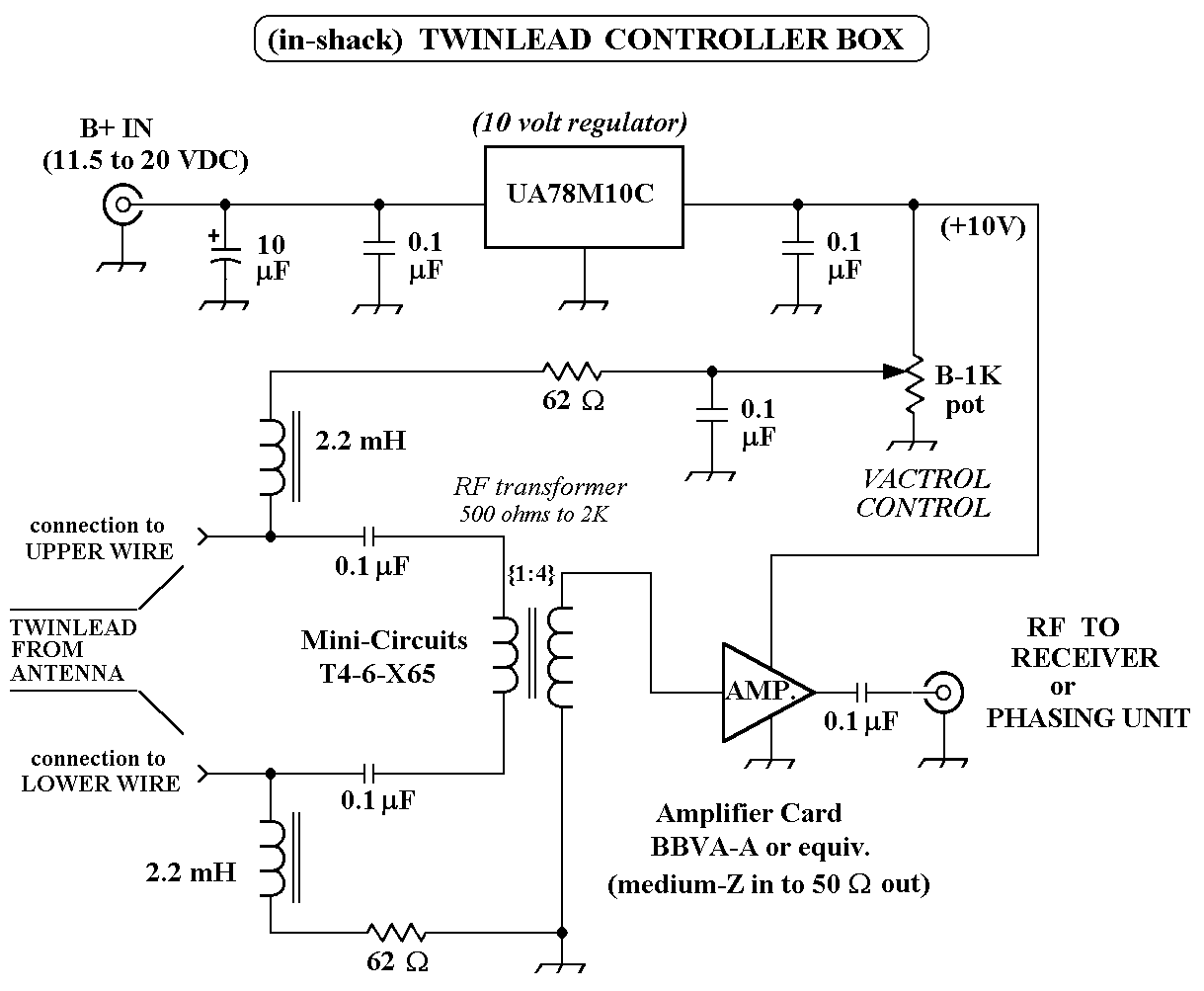
Figure 3: Coaxial Controller Box
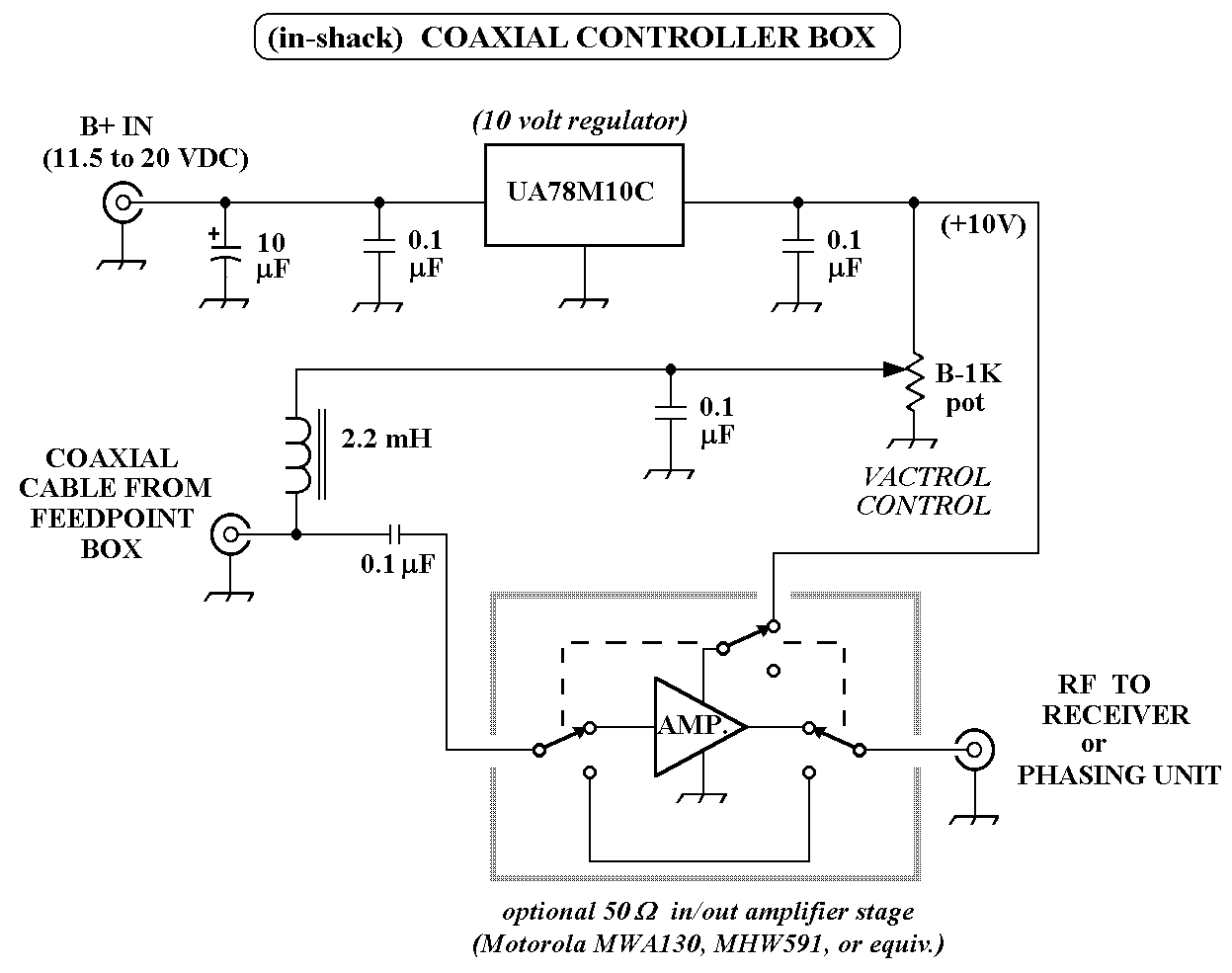
Figure 4: Feedpoint Box (for Coaxially-Fed System)
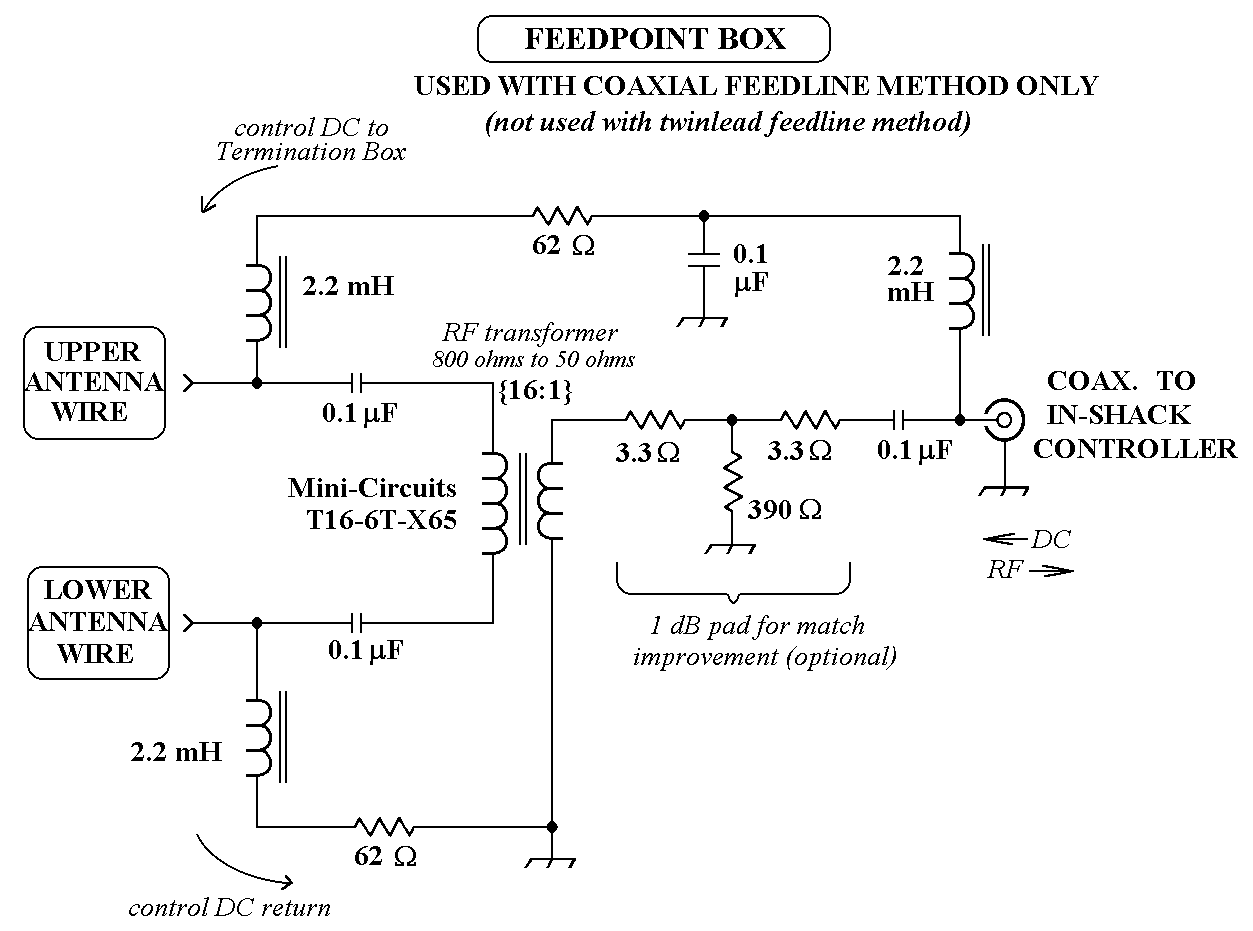
Figure 5: Termination Box
